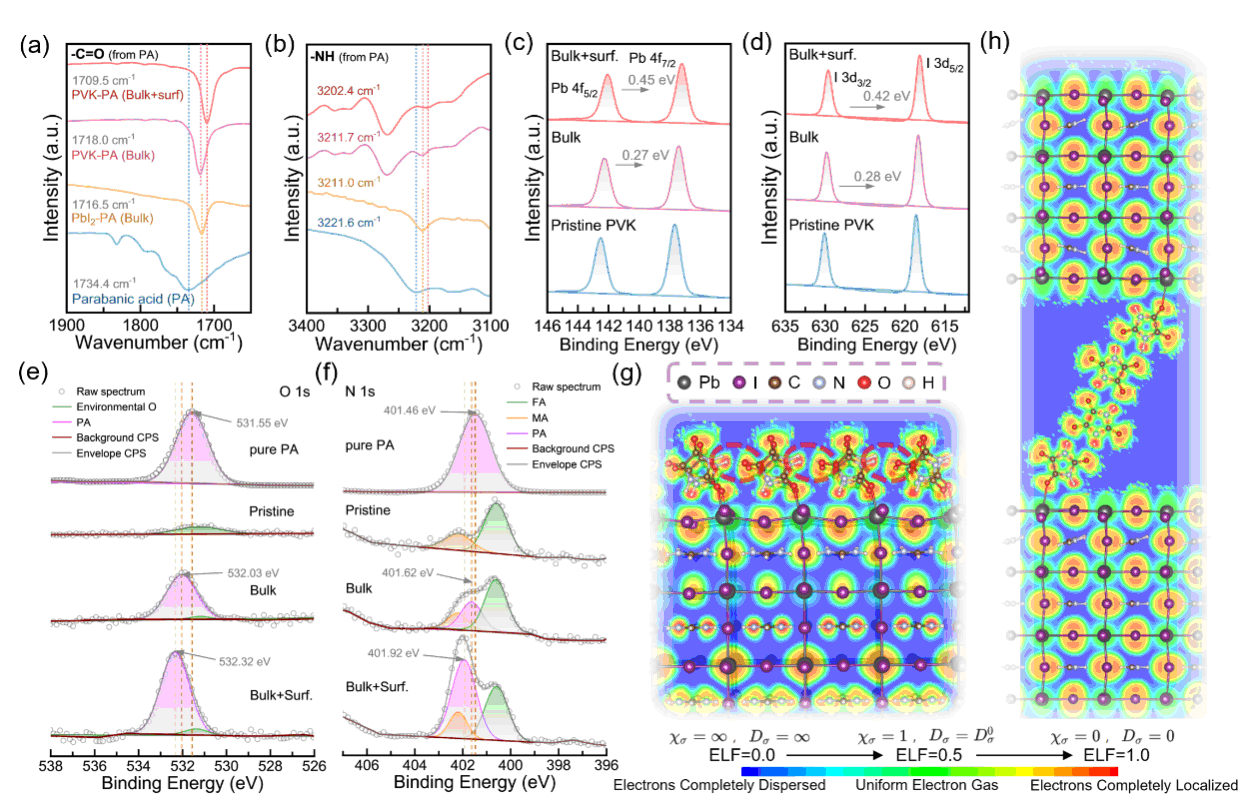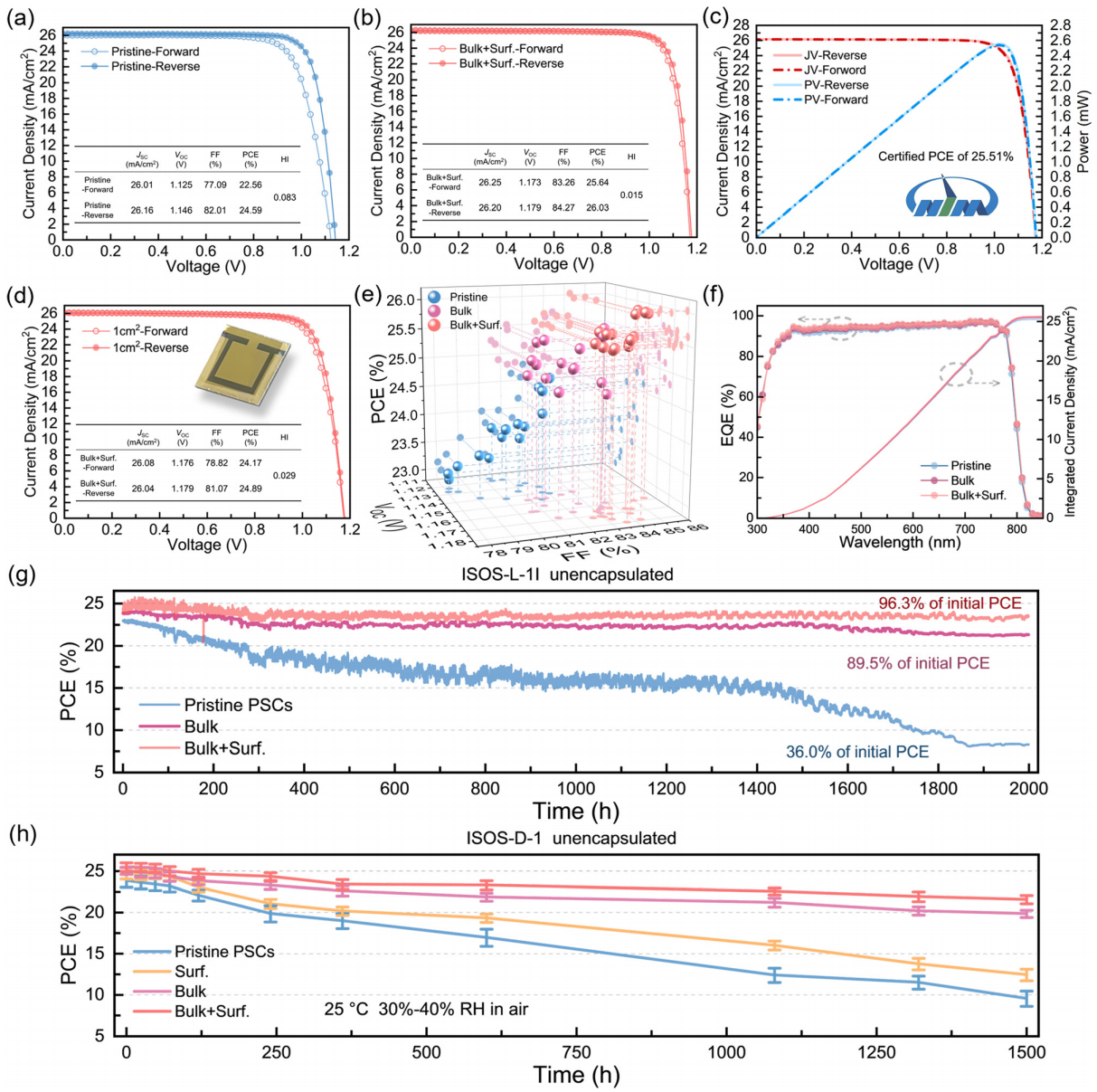Metal halide perovskites have emerged as promising photovoltaic materials due to their excellent optoelectronic properties and low-cost fabrication techniques. However, the performance and stability of perovskite solar cells (PSCs) are significantly affected by the random orientation of optically active crystal phases and defects in the bulk and at interfaces. To address this, Professor Yi Chenyi’s research group from the Department of Electrical Engineering and Applied Electronics (EEA) at Tsinghua University has developed a multifunctional organic molecule, picolinic acid (PA), to regulate crystallization and form perovskite films with highly oriented out-of-plane alignment. PA was also used for interfacial treatment, enabling synergistic passivation of bulk and interfacial defects in PSCs. The resulting devices achieved a power conversion efficiency (PCE) of 26.03% (certified at 25.51%) and demonstrated excellent environmental stability. Under ISOS-L-1I accelerated aging conditions, the PSCs retained 96.3% of their initial efficiency after 2000 hours of continuous operation at the maximum power point. This approach, based on additive-mediated crystallographic orientation regulation and comprehensive defect passivation, offers a new pathway to advance perovskite solar cell technology. The results were published in Energy & Environmental Science.

Figure 1: Analysis and Mechanism Illustration of Additive-Regulated Perovskite Crystal Orientation
The researchers added picolinic acid (PA) to perovskite compositions to control crystallization and further deposited a PA passivation layer on the perovskite surface to suppress surface defects. To investigate the effect of PA on the crystallization process of perovskite (PVK) films, they conducted in situ grazing-incidence wide-angle X-ray scattering (GIWAXS) studies. Results showed that PA doping induced a significant change in the orientation of the (100) crystal plane, shifting toward a more concentrated out-of-plane orientation. By integrating GIWAXS images from 50 to 100 seconds during annealing, they observed that the orientation change correlated with increasing annealing temperatures. X-ray diffraction (XRD) analysis confirmed improved crystallinity of the (100) plane and reduced residual PbI₂ content in PA-assisted films, avoiding performance degradation caused by excessive PbI₂.

Figure 2: Experimental and Theoretical Analysis of Additive Molecules' Impact on Perovskite Film Surface Defects
Fourier-transform infrared spectroscopy (FTIR) and X-ray photoelectron spectroscopy (XPS) revealed the interaction mechanisms between PA and the perovskite structure. Specifically, the carbonyl group (-C=O) in PA coordinates with lead (Pb) ions in the perovskite, and the amino group (-NH) forms hydrogen bonds with iodine (I) ions. Density functional theory (DFT) calculations further supported these findings, elucidating the mechanisms by which PA regulates crystallization and passivates surface defects in perovskite materials.
Tests on complete solar cell devices demonstrated significant improvements in photovoltaic performance for PSCs with dual PA treatment compared to untreated and single-treatment (either bulk doping or interfacial treatment alone) devices. PSCs with dual PA treatment achieved a high PCE of 26.03%, with a third-party certified efficiency of 25.51%. Devices with an effective area of 1 cm⟡ achieved a PCE of 24.86%. The efficiency improvement was primarily attributed to the reduction in non-radiative recombination losses and effective defect passivation in both the perovskite bulk and interface. In stability tests, the dual-treated PSCs exhibited outstanding durability. Under ISOS-L-1I accelerated aging conditions, the cells retained 96.3% of their initial efficiency after 2000 hours of continuous operation at the maximum power point. In contrast, untreated PSCs retained only 36.0% of their initial performance. Even under high temperature (85°C) and high humidity (50%-80% RH at 25°C), the dual-treated PSCs demonstrated excellent stability.

Figure 3: Effects of Additive Molecules on Efficiency and Stability of Perovskite Solar Cells
The multifunctional additive's synergistic role in crystallization control, spatial orientation regulation, and interfacial defect passivation highlights its tremendous potential in enhancing both the efficiency and stability of perovskite solar cells.
Professor Yi Chenyi of EEA is the corresponding author of the paper, with Jiao Boxing, Tan Liguo, Ye Yiran, and Ren Ningyu listed as co-first authors. The research was supported by the National Key R&D Program and the National Natural Science Foundation of China.
Paper link: https://doi.org/10.1039/D5EE00189G

















 News & Events
News & Events